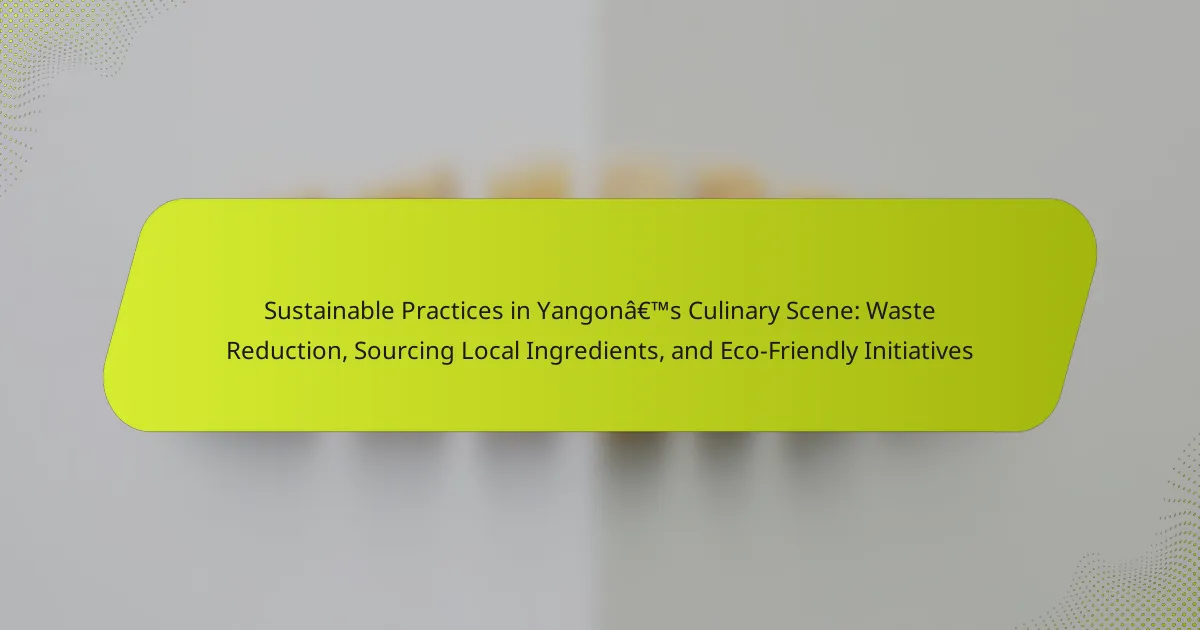Sustainable practices in Yangon’s culinary scene focus on waste reduction, sourcing local ingredients, and implementing eco-friendly initiatives. Restaurants are adopting composting methods and zero-waste cooking techniques to minimize food waste and utilize every part of an ingredient. Chefs prioritize seasonal and locally sourced produce, fostering relationships with local farmers and participating in community-supported agriculture programs. These practices not only support local economies but also enhance consumer health by providing fresher, organic food options. As a result, there is a growing consumer willingness to invest in sustainable brands, reflecting a trend towards ethical consumption and long-term environmental health.

What are Sustainable Practices in Yangon’s Culinary Scene?
Sustainable practices in Yangon’s culinary scene include waste reduction, sourcing local ingredients, and eco-friendly initiatives. Restaurants are increasingly adopting composting methods to minimize food waste. Many chefs prioritize using seasonal and locally sourced produce to support local farmers. This approach reduces carbon footprints associated with transportation. Some establishments implement zero-waste cooking techniques to ensure every part of an ingredient is utilized. Additionally, eco-friendly packaging is becoming common in takeout services. These practices contribute to a more sustainable food system in the city.
How do these practices contribute to environmental conservation?
Sustainable practices in Yangon’s culinary scene contribute to environmental conservation by reducing waste, promoting local sourcing, and implementing eco-friendly initiatives. Waste reduction minimizes landfill contributions and lowers greenhouse gas emissions. Sourcing local ingredients decreases transportation emissions and supports local economies. Eco-friendly initiatives, such as composting and using biodegradable materials, enhance soil health and reduce pollution. These practices collectively foster a sustainable food system, which is essential for preserving biodiversity and protecting natural resources.
What are the key components of waste reduction in culinary settings?
Key components of waste reduction in culinary settings include inventory management, portion control, and composting. Inventory management helps minimize over-purchasing and spoilage. Proper portion control reduces food waste by ensuring appropriate serving sizes. Composting transforms organic waste into nutrient-rich soil, diverting waste from landfills. Implementing these practices can lead to significant reductions in waste. According to the Food Waste Reduction Toolkit by the USDA, effective inventory management can reduce food waste by up to 30%.
How does sourcing local ingredients impact sustainability?
Sourcing local ingredients enhances sustainability by reducing transportation emissions. When ingredients are sourced nearby, the carbon footprint associated with long-distance shipping decreases significantly. For example, a study indicated that local food transportation can emit up to 10 times less CO2 compared to imported options. Additionally, local sourcing supports regional economies, fostering community resilience. This practice often promotes biodiversity by encouraging farmers to grow a variety of crops suited to local conditions. Furthermore, utilizing seasonal local produce minimizes reliance on energy-intensive greenhouse farming. Overall, sourcing local ingredients contributes to a more sustainable food system by lowering environmental impact and supporting local communities.
Why is waste reduction important in Yangon’s culinary landscape?
Waste reduction is crucial in Yangon’s culinary landscape to minimize environmental impact. The city faces significant waste management challenges, with restaurants contributing to landfill overflow. Reducing waste can lower operational costs for culinary businesses. It also enhances the sustainability of local food systems. Furthermore, waste reduction aligns with global trends toward eco-friendly practices. Studies show that reducing food waste can decrease greenhouse gas emissions significantly. Implementing waste reduction strategies can improve community health by decreasing pollution. Ultimately, waste reduction fosters a more sustainable future for Yangon’s culinary scene.
What types of waste are most commonly generated in restaurants?
The most commonly generated types of waste in restaurants include food waste, packaging waste, and hazardous waste. Food waste consists of uneaten food, kitchen scraps, and expired ingredients. Packaging waste arises from materials like plastic, cardboard, and glass used for food and beverage storage. Hazardous waste may include cleaning chemicals and broken glass. According to the Food Waste Reduction Toolkit by the U.S. Environmental Protection Agency, food waste accounts for approximately 22% of municipal solid waste. This data highlights the significant impact of waste generated in the restaurant industry.
How can restaurants measure their waste output effectively?
Restaurants can measure their waste output effectively by implementing a systematic tracking process. This involves conducting regular waste audits to categorize and quantify waste types. For instance, restaurants can weigh food waste daily to identify trends and sources of waste. They can also utilize digital tools or apps designed for waste management tracking. These tools can help in recording waste data and generating reports. Furthermore, staff training on waste reduction practices can enhance awareness and accuracy in measurements. A study by the Food Waste Reduction Toolkit indicates that systematic tracking can reduce waste by up to 30%. This evidence supports the effectiveness of these methods in measuring waste output accurately.

What are the methods of sourcing local ingredients in Yangon?
Local ingredients in Yangon are sourced through various methods. Farmers’ markets play a significant role in connecting local producers with consumers. These markets offer fresh produce directly from farmers. Restaurants often establish relationships with local farmers to ensure a steady supply of seasonal ingredients. Community-supported agriculture (CSA) programs are also popular. These programs allow consumers to buy shares of a farm’s harvest. Additionally, urban foraging is becoming more common in Yangon. Chefs explore local parks and green spaces for edible plants. Sourcing local ingredients supports the local economy and promotes sustainability.
How does local sourcing benefit the community and environment?
Local sourcing benefits the community and environment by promoting economic growth and reducing carbon footprints. It supports local farmers and businesses, enhancing the local economy. This practice encourages sustainable agriculture methods, which preserve soil health and biodiversity. Additionally, local sourcing minimizes transportation emissions, as products travel shorter distances. According to the USDA, locally sourced food can reduce greenhouse gas emissions by up to 25%. This contributes to cleaner air and a healthier ecosystem. Furthermore, it fosters community connections, as consumers engage with local producers. Overall, local sourcing strengthens community resilience and environmental sustainability.
What challenges do chefs face when sourcing locally?
Chefs face several challenges when sourcing locally. Limited availability of seasonal ingredients is a significant issue. Local farmers may not produce enough variety to meet chefs’ demands. Quality inconsistencies can arise from varying farming practices. Transportation logistics can complicate timely ingredient delivery. Price fluctuations occur due to supply and demand dynamics. Chefs may also encounter a lack of established relationships with local producers. Regulatory restrictions can limit sourcing options. These challenges make it difficult for chefs to consistently provide fresh, local dishes.
How can chefs establish relationships with local farmers?
Chefs can establish relationships with local farmers by directly engaging with them. They can visit farmers’ markets to meet producers in person. Building rapport through regular communication is essential. Chefs should express their interest in sourcing local ingredients. Collaborating on seasonal menus can create mutual benefits. Offering to promote farmers’ products in their restaurants fosters loyalty. Hosting farm-to-table events can strengthen connections. Participating in community-supported agriculture (CSA) programs provides consistent access to fresh produce. These actions enhance trust and collaboration between chefs and farmers.
What role do eco-friendly initiatives play in culinary practices?
Eco-friendly initiatives play a crucial role in culinary practices by promoting sustainability and reducing environmental impact. These initiatives encourage the use of local ingredients, minimizing transportation emissions. They also support waste reduction through composting and recycling programs. Restaurants adopting these practices often implement energy-efficient appliances to lower energy consumption. Additionally, eco-friendly initiatives can enhance a restaurant’s brand image, attracting environmentally conscious consumers. Studies show that sustainable practices can lead to cost savings in the long term. Overall, these initiatives contribute to a healthier planet while improving culinary quality.
What are some examples of eco-friendly initiatives in Yangon?
Yangon has implemented several eco-friendly initiatives. One example is the promotion of community gardens. These gardens encourage local food production and reduce reliance on imported goods. Another initiative is the use of biodegradable packaging by local restaurants. This reduces plastic waste in the environment. Additionally, Yangon has initiated tree planting campaigns. These campaigns aim to increase urban green spaces and improve air quality. Local markets are also encouraging the use of reusable bags. This helps to minimize single-use plastic consumption. These initiatives collectively contribute to a more sustainable urban environment in Yangon.
How can restaurants implement these initiatives successfully?
Restaurants can implement sustainable initiatives successfully by adopting clear strategies. First, they should establish a waste reduction program. This includes composting organic waste and recycling materials. Second, sourcing local ingredients can significantly reduce carbon footprints. Collaborating with local farmers ensures fresher produce and supports the community. Third, restaurants should educate staff on sustainability practices. Training employees fosters a culture of environmental responsibility. Fourth, measuring and tracking sustainability metrics can provide insights into progress. Regular assessments help identify areas for improvement. Finally, engaging customers through awareness campaigns promotes community involvement. Research shows that restaurants adopting these practices can enhance their brand image and customer loyalty.

What are the impacts of sustainable practices on consumers?
Sustainable practices positively impact consumers by enhancing their health and well-being. These practices often lead to fresher, organic food options. Consumers benefit from reduced exposure to harmful chemicals and pesticides. Sustainable sourcing promotes local economies, which can improve community relationships. Many consumers feel a sense of satisfaction supporting environmentally friendly initiatives. Research shows that 66% of consumers are willing to pay more for sustainable brands. This willingness reflects a growing trend towards ethical consumption. Sustainable practices also contribute to long-term environmental health, which benefits all consumers.
How do consumers perceive sustainable dining options?
Consumers generally view sustainable dining options positively. They appreciate the environmental benefits associated with these practices. Many consumers are increasingly aware of climate change and its impacts. This awareness drives them to seek out eco-friendly dining choices. Research indicates that 66% of consumers are willing to pay more for sustainable food options. This statistic highlights a growing trend towards prioritizing sustainability in dining. Additionally, consumers often associate sustainable dining with higher food quality. They believe that local sourcing enhances freshness and flavor. Overall, the perception of sustainable dining is linked to ethical consumption and health consciousness.
What are the benefits of choosing sustainable restaurants for consumers?
Choosing sustainable restaurants benefits consumers by promoting health, supporting local economies, and reducing environmental impact. Sustainable restaurants often use fresh, organic ingredients. This leads to healthier meal options. Additionally, they typically source food from local suppliers. This practice strengthens community ties and boosts local economies. Sustainable dining also minimizes waste through eco-friendly practices. For example, many sustainable restaurants implement composting and recycling. This reduces landfill contributions and promotes environmental responsibility. Overall, dining sustainably aligns consumer choices with ethical and health-conscious values.
What practical steps can restaurants take to adopt sustainable practices?
Restaurants can adopt sustainable practices by implementing waste reduction strategies. They can start by minimizing food waste through better inventory management. This includes tracking expiration dates and using ingredients efficiently. Composting organic waste is another effective step. It diverts waste from landfills and enriches soil.
Sourcing local ingredients is crucial for sustainability. Restaurants can build relationships with local farmers and suppliers. This reduces transportation emissions and supports the local economy. Seasonal menus can also promote the use of fresh, local produce.
Implementing eco-friendly initiatives is essential. Restaurants can switch to biodegradable packaging and utensils. Reducing plastic usage significantly lowers environmental impact. Energy-efficient appliances can also be installed to decrease energy consumption.
Training staff on sustainable practices enhances overall effectiveness. Educating employees about waste reduction and local sourcing fosters a culture of sustainability. Regularly reviewing and updating sustainability practices keeps restaurants aligned with environmental goals.
How can restaurants create a waste reduction plan?
Restaurants can create a waste reduction plan by assessing their current waste management practices. They should conduct a waste audit to identify types and amounts of waste produced. This data helps in setting specific reduction goals. Implementing portion control can minimize food waste significantly. Training staff on waste reduction techniques is essential for compliance. Establishing partnerships with local food banks can facilitate food donation. Utilizing composting systems for organic waste is beneficial for sustainability. Regularly reviewing and adjusting the waste reduction plan ensures continuous improvement. These steps contribute to a more sustainable culinary operation.
What are the best practices for sourcing local ingredients?
Best practices for sourcing local ingredients include establishing relationships with local farmers and producers. This ensures fresh, seasonal ingredients that support the local economy. Visiting farmers’ markets provides direct access to a variety of local produce. Engaging in community-supported agriculture (CSA) programs offers a consistent supply of local goods. Prioritizing organic and sustainable farming methods enhances food quality and environmental health. Utilizing local food directories can help identify available sources in the area. Additionally, collaborating with local chefs and restaurants fosters a network of shared resources. These practices not only promote sustainability but also strengthen community ties.
Sustainable practices in Yangon’s culinary scene encompass waste reduction, sourcing local ingredients, and implementing eco-friendly initiatives. The article details how these practices contribute to environmental conservation by minimizing waste, promoting local economies, and enhancing food quality. Key components include effective waste management strategies, the benefits of local sourcing for sustainability, and the challenges faced by chefs in establishing connections with local farmers. Additionally, it highlights the positive impacts of sustainable dining options on consumer health and community resilience, along with practical steps restaurants can take to adopt these practices.
